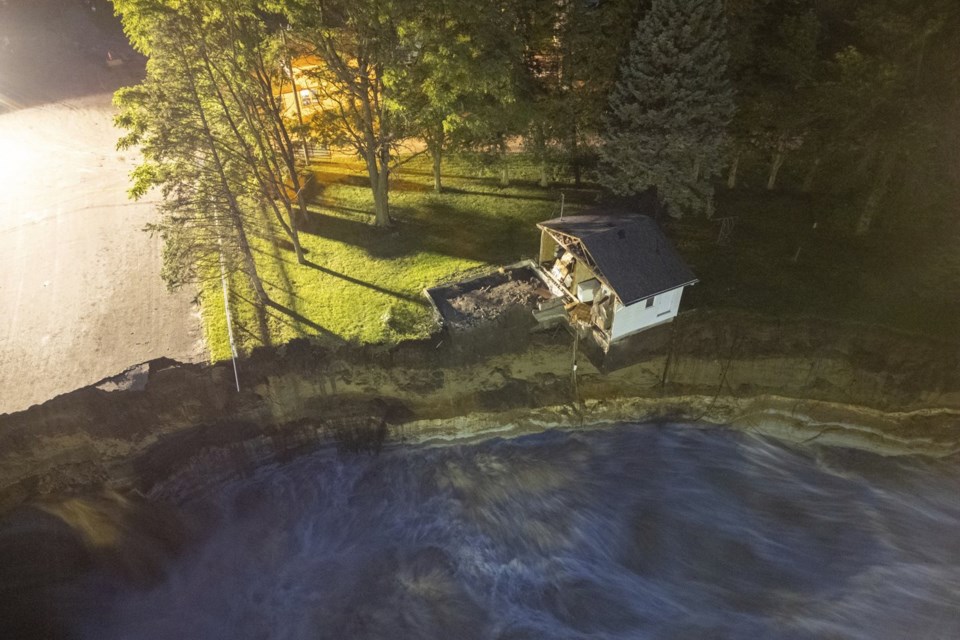MINNEAPOLIS (AP) — The visuals were stunning: Water from the Blue Earth River surged around a , carrying a shipping container with it as it toppled utility poles, wrecked a substation and washed away part of a riverbank. A home on the edge of the eroded slope collapsed into the river.
Earlier this week, authorities said the Rapidan Dam near Mankato faced an “imminent threat” of collapse but later said an abutment had partially failed. The river swelled after an pummeled the Midwest for days.
On Wednesday, the dam was still intact and there were no mass evacuations. Authorities said the partial failure of the abutment was caused by the recent bout of heavy rain, but a past assessment of the dam revealed it was already at risk. Here are some things to know.
What happened?
Early Monday morning, emergency management workers gave notice that water was surging over the dam. As water flows peaked, debris plugged parts of the structure and the west abutment of the dam partially failed. Conditions around the dam spun a current that was too vicious for workers to cross safely to clear the detritus.
The rush of water destroyed a power station and caused outages for about 600 households, Minnesota Gov. Tim Walz said. Water levels peaked Monday at 34,800 cubic feet per second — the normal flow is 500 cubic feet per second. Those figures make this flood the second largest in the dam’s history and the equivalent of once-a-century flooding.
The levels had begun to lower by Tuesday, county officials said.
Water continued flowing around and eroding the west side of the dam Tuesday, officials said. But as overall water levels decreased, they said the prospect of a total collapse was unlikely.
What was the condition of the dam?
Construction of the Rapidan Dam was finished in 1910 and is described by the county as a hollow concrete dam, founded on sandstone bedrock in a steep, U-shaped valley. The dam is approximately 475 feet (145 meters) long and 87 feet (27 meters) high.
It was built to generate electricity, but flooding damaged it enough in 1965 that it didn't provide power for nearly 20 years, according to an engineering report. prepared by a Minneapolis firm in 2021, said emergency repairs were required in 2002 because of “extensive undermining” of its foundation. Four more rounds of repairs followed through 2018. Flood damage in 2019 and 2020 stopped the generation of power again.
In 2019, the dam experienced what was one of its highest floods on record. Severe weather from that flood and other rainfall since have caused significant damage to the dam’s structure and usability, to Blue Earth County, which said the dam was in a “state of disrepair.”
Further damage occurred, and an April 2023 assessment conducted by the National Inventory of Dams found Rapidan to be in poor condition.
Officials have not said whether the issues identified in past assessments led to the partial failure.
“The structural integrity of the dam has been in question for a long time,” Walz said. “The removal of the dam has been a question that’s been up there.”
What are the dangers to surrounding areas?
Areas downstream of the dam have no permanent inhabited structures, reducing the risk of fatalities and property damage, county officials said. But officials closed a park downstream that attracts hikers and fishermen.
The reservoir upstream of the dam provides power generation storage and recreation. But it is full of sediment, making boat access difficult, the county said. Because the reservoir is full, sediment is now pushed downstream of the dam.
Blue Earth County Public Works Director Ryan Thilges said there is more than a century's worth of sediment upstream of the dam. Severe environmental damage could occur if that sediment were to break loose and seep into the river, he said.
What would it cost to repair the dam?
The 2021 engineering report put the cost of repairing the dam at $15.2 million — in addition to more than $6 million that the county had spent since 2002.
But the following year raised questions about the idea. It said that even if the dam's ability to generate electricity were restored, the county still would likely lose money — an average of almost $107,000 annually for each of the following 40 years.
And the 2021 engineering report said that after 40 years, the county still would face the same issue — whether to remove the dam. It said repairs would require three years of planning and a year of construction.
Could the county remove the dam?
by the same engineering firm suggested that removing the dam would have benefits. It called the potential move “an outstanding opportunity to re-establish a free-flowing river" while turning the former lake into 360 acres of parkland.
The actual removal of the dam would cost $10 million, but the project would come with a lot of other costs, such as stabilizing riverbanks, preventing erosion and replacing a county road bridge over the dam — increasing the potential costs to $82 million.
What's more, the report said, it could require five years of planning and another five years of work afterward. The report said the Minnesota Legislature might be required to authorize bonds to pay for it.
The work would require the county to install a temporary dam upstream and divert the river around the Rapidan Dam so crews could work on dry ground and bring in equipment.
“Sometimes it’s explosives. Sometimes it’s less dramatic — it’s a backhoe coming and hacking away at it,” said Amy Souers Kober, spokesperson and a vice president for the conservation group American Rivers, which monitors dam safety issues.
___
Hanna reported from Topeka, Kansas.
Michael Goldberg And John Hanna, The Associated Press




